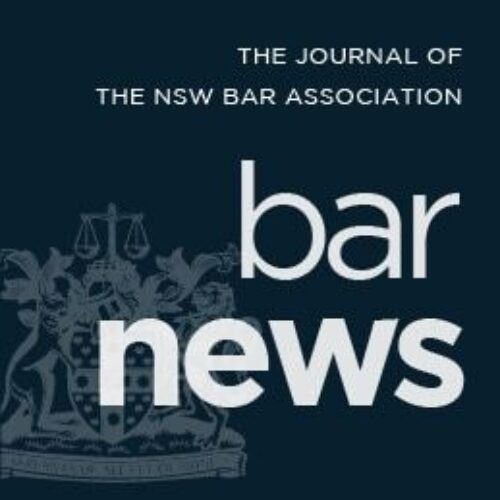- Summer 2023
- Common Law, Equity and Statute: A Complex Entangled System By Mark Leeming (Federation Press, 2023)
Common Law, Equity and Statute: A Complex Entangled System By Mark Leeming (Federation Press, 2023)

How do judges make law? This is the central question of this fascinating book by Justice Mark Leeming of the New South Wales Court of Appeal. Leeming JA is well placed to answer this question, having sat on over 1,000 civil and criminal appeals since his appointment in 2013, involving countless hours of reading, listening, thinking and writing about the appellate process.
To answer the question posed, the historical excursion one takes on reading this book begins with Christopher St German, and his work on chancery procedure, A Little Treatise Concerning Writs of Subpoena (1523). It passes through the sinking of the convict ship The Juliana in the Thames (1814), in respect of which Lord Stowell observed that equity is concerned with ‘every connected circumstance’ to determine the ‘real justice of the case’. It moves on to the High Court’s consideration of the true characterisation of Bankstown City Council’s liability for the flooding of land in Alamando (2005), before taking up incoming Chief Justice Gageler’s 2011 extracurial observation that the law which is applied in most modern cases ‘has its source in the text of a statute’.
By ‘making law’, Leeming JA focuses attention on the small minority of cases where the courts, and in particular appellate courts, go beyond applying the existing law to the facts at hand. Rather, we are in the realm where the existing law provides no clear answer, able arguments are put by counsel offering different solutions, and the court must decide the direction the law is to take. Taking his lead from Alamando, Leeming JA describes contemporary Australian law as a complex entanglement between the ‘rules of law’, the ‘principles of equity’, and the ‘requirements of statute’.
The process of ‘making law’ can thus be understood as a process of untangling these three separate strands to answer the problem raised by the individual case or appeal. Leeming JA offers a valuable analytical framework that typically starts with the statute, and then seeks to draw upon the ‘unwritten law’ of the common law and equity to arrive at the answer. However, one cannot undertake the disentanglement task without first having a deep understanding about each strand historically and analytically.
Chapters 3 and 4 deal specifically with statutes, how to classify them and how courts have approached their interpretation. Note to all appellate advocates: these chapters provide invaluable insights for the typical, but difficult, task of identifying what a particular provision actually means. This is not the only place where the author’s work resembles that of an insightful scientific analysis of how a particular ecosystem works, by identifying individual species of animals and plants, and describing both their particular characteristics and how they interact with each other.
Because statutes do not exist in a vacuum, knowledge of the common law, and in particular the ‘principles’ of equity, are essential to the work that lawyers and courts must undertake in solving any given legal problem. In chapters 5, 6 and 7, Leeming JA addresses the fallacies often surrounding the judicature legislation, and mounts a strong argument for the continuing relevance of equitable thought and the ‘principles’ of equity. Of the distinction between the two, Leeming JA makes the point that ‘rules work well in simple cases’, but ‘principles… create greater certainty…in complex areas’. This is also illustrated by a quote from Allsop CJ, who cautioned, extracurially, that having ‘precise rules for all circumstances may be to risk complexity, incoherence and confusion’. The complex issues arising in relation to statutory unconscionability brings to mind one of many circumstances in which Leeming JA’s analysis is and will be invaluable to courts and advocates alike.
The final section of the book draws the individual strands together by focussing attention on the structure and consequence of ‘Judge-made Law in Australia’, in chapters 8, 9 and 10. Here, Leeming JA surveys a broad landscape of legal disputes, from constitutional law, contract and torts to defamation and crime, in the context of seeking to elucidate what is meant by the ‘common law of Australia’ – a statement attributed to Lange. Although the author acknowledges that this issue, raising questions about the interrelationship of different federal and state statutes, rarely causes any practical difficulties, it is consideration of the rarer type of case that returns the reader to the central question of the book: ‘How do judges make law?’
Ultimately, the charm of this work is its accessibility and readability, while retaining the essential features of both a scholarly work (with over 1,400 footnotes) and also serving as a practical text for advocates. The work starts, creatively, with an opening dialogue between a teacher and two students, provided as a transcript rather than prose – which sparks interest and curiosity in the themes to be developed as the book unfolds. The use of similar dialogues marks the start of distinct parts of the book, and it ends in a similar vein with a closing dialogue.
If ever a case were to be made for the difficulty of applying Artificial Intelligence to dispute resolution, this work makes out that case, by demonstrating that the courts, in striving to determine ‘the real justice of the case’, must undertake a principled, informed and yet creative untangling of the complex interaction of statute, common law and equity. For these reasons this work is highly recommended.

